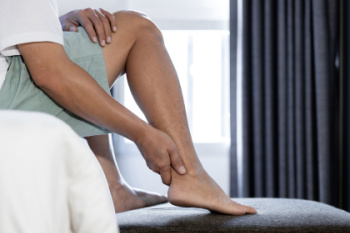
A ruptured, or torn Achilles tendon is a serious injury that can significantly affect movement of the foot and ankle. The Achilles tendon connects the calf muscles to the heel bone, which make walking, running, jumping, and standing on the toes possible. Achilles tendon ruptures often occur during sports that require sudden changes in direction or explosive leg movements, such as basketball, tennis, or soccer. A complete rupture typically causes a sharp pain in the back of the ankle, sometimes with a popping sound. This is followed by difficulty pointing the toes downward or bearing weight. A podiatrist can evaluate the injury through a physical exam and imaging tests to determine the extent of the tear. Surgery is often recommended for a full rupture to reattach the torn tendon, especially in younger or more active patients. After surgery, a podiatrist may use a cast or boot to immobilize the foot during healing. Prompt treatment is important to reduce the risk of long-term weakness or re-injury. If you have torn or injured your Achilles tendon, it is suggested that you schedule an appointment with a podiatrist for appropriate treatment.
Achilles tendon injuries need immediate attention to avoid future complications. If you have any concerns, contact Luis Esquerdo Cruz, DPM of Dr. Esquerdo Podiatry and Laser Center
. Our doctor can provide the care you need to keep you pain-free and on your feet.
What Is the Achilles Tendon?
The Achilles tendon is a tendon that connects the lower leg muscles and calf to the heel of the foot. It is the strongest tendon in the human body and is essential for making movement possible. Because this tendon is such an integral part of the body, any injuries to it can create immense difficulties and should immediately be presented to a doctor.
What Are the Symptoms of an Achilles Tendon Injury?
There are various types of injuries that can affect the Achilles tendon. The two most common injuries are Achilles tendinitis and ruptures of the tendon.
Achilles Tendinitis Symptoms
- Inflammation
- Dull to severe pain
- Increased blood flow to the tendon
- Thickening of the tendon
Rupture Symptoms
- Extreme pain and swelling in the foot
- Total immobility
Treatment and Prevention
Achilles tendon injuries are diagnosed by a thorough physical evaluation, which can include an MRI. Treatment involves rest, physical therapy, and in some cases, surgery. However, various preventative measures can be taken to avoid these injuries, such as:
- Thorough stretching of the tendon before and after exercise
- Strengthening exercises like calf raises, squats, leg curls, leg extensions, leg raises, lunges, and leg presses
If you have any questions please feel free to contact our office located in San Juan, PR . We offer the newest diagnostic tools and technology to treat your foot and ankle needs.